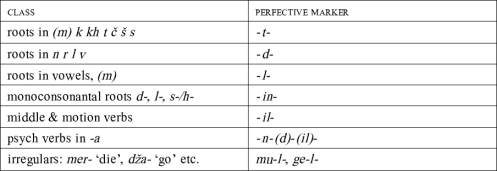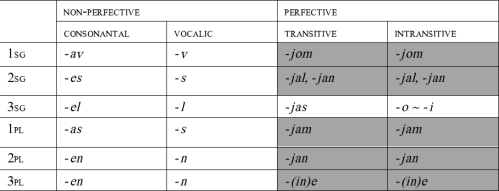The structure of Romani
Verbs
Valency and loan verb integration
ER inherited a set of valency-changing morphemes, reminiscent of MIA verb morphology. Two valency-increasing markers, ‑av‑ and ‑ar‑, were old, and their productivity appears to have been restricted. Nonetheless, they continued to play a role in the formation of causatives and in the formation of transitive verbs from non-verbs (adjectives, participles, and to some extent also nouns). Alongside these two markers there was a younger valency-increasing morpheme, ‑ker‑, a grammaticalisation of the verb ker‑ ‘to do’. This marker played a slightly more active role in word-formation, especially in deriving transitive verbs from nouns. It appears that ‑ker‑ also combined with the two older morphemes as a means of strengthening their valency structure (‑av-ker‑, ‑ar-ker‑). Transitive word-formation also relied on another verb, d‑ ‘to give’, which however seems to have been confined to lexical derivations, and did not have a grammaticalised valency-increasing function. The common valency-decreasing morpheme was ‑jov‑, derived originally from the verb ov‑ ‘to become’. It was used productively with transitive participles to derive middles or ‘mediopassives’ (kerdo ‘done’, kerdjov‑ ‘to be done’), and with adjectives and some nouns to derive inchoatives. Another marker, ‑áv‑, emerged in similar function, and appears to have enjoyed even greater productivity that ‑jov‑ in ER, although variation seems quite likely, and dialects differ in their retention and distribution of the two. This later marker derives from the grammaticalised verb av‑ ‘to come’, which appears to have been used at least as variant in similar functions to ov‑ ‘to become’. Though internal grammaticalisation is a possibility, contact influence from Kurdish hatin ‘to come’, which is also used as an intransitive auxiliary, may have played a role in the late Proto-Romani period, immediately preceding ER.
Valency markers appeared to have played a role in the integration patterns of loan verbs. In ER, there appears to have been a free license to integrate Greek lexicon, including verbs, with the exception perhaps of a limited range of semantic domains. Greek verbs will have been adopted with their inflection class markers, such as ‑ín‑, ‑íz‑, etc., which in turn also marked tense (present vs. aorist). Thus, Greek-derived verbs continued to carry Greek-derived tense inflection when used in Romani (jiríz‑ ‘to go’, jirís‑ ‘to have gone’; graf‑ ‘to write’, graps‑ ‘to have written’, etc.). The Greek stem with inflection class marker was then followed by an internal, Romani ‘verbaliser’, marking out valency and so assigning the borrowed stem its status as a verb within the recipient language. This system could have been inherited from the older Indo-Aryan ancestor language, or it could simply have emerged in congruence with a strategy for adapting loan verbs that was, and still is, common in the western Asian area (cf. Turkic, Iranian, and Indo-Aryan languages) (see discussion in Matras 2002: 128-135). The markers involved were the transitive markers ‑av‑, ‑ar‑, and ‑ker‑, with transitive verbs, and ‑áv‑ with intransitive verbs. These were then followed by the regular Romani tense-aspect-mood and concord markers, so that the entire, complex strategy of loan verb inflection constituted in effect a derivational strategy, even though it was sensitive to Greek inflection class membership. As with nouns, this system of integrating loan verbs by respecting and marking out their Greek-based inflection class affiliation became a stable component of the language. As contacts extended beyond Greek, loans verbs from the new contact languages were initially incorporated into the same, Greek-oriented system. With the declining number of Greek verbal roots, and the increasing number of loan verbs from other contact languages following the dispersion of the dialects, the assignment of Greek-based inflection class became, of course, dysfunctional. The outcome was a series of dialect-specific levelling processes, applied to the full paradigm of ER loan verb adaptation marking (see Chapter 15 for details). In effect, one or several loan verb markers were generalised. These may contain, in individual dialects, just a Greek-derived morpheme (e.g. ‑in‑), or just a valency morpheme (e.g. ‑ar‑), or traces of both (e.g. ‑is‑ar‑, ‑is‑ker‑). Valency distinctions are consequently no longer strictly observed in the dialects, either, though the original ER past-tense intransitive marker ‑is‑ájl‑ from *‑is‑áv-il‑ continues to function, in many dialects, as a specific past tense formation for intransitive loans. In some dialects, this adaptation system is also applied to new formations within the pre-European component, such as iterative ‑in-ker‑ or inchoative ‑is-aj‑.
Inflection classes
ER had distinct inflection classes for non-perfective and perfective (sometimes called past, aorist, or preterit) stems. In the non-perfective stems, there were two classes, a consonantal class (ker‑ ‘to do’), which included the majority of verbs, and a rather marginal vocalic class (xa‑ ‘to eat’). The difference between the two non-perfective classes is merely in the shape of the vowel that connects the stem to the subject concord marker (see Section 4.3).
The class division among perfective stems was somewhat more complex. Here, the differences were in the form of the perfective marker which attached to the root to form the perfective stem. These perfective markers all derive from an inventory of OIA/MIA participial and adjectival inflections, a development which goes back to the loss of the old past-tense formation and the generalisation in early NIA of participles instead. The most common marker in Romani is the historical *‑t‑, which took on various forms in different phonological environments. It appears that the original ‑t‑ was retained in ER with roots in voiceless consonants, and to some extent with roots in /m/. The latter had already begun to move into a different class, namely that in ‑l‑, and this process continued in most dialects with the roots in voiceless consonants, to different extents. The same historical participle marker was voiced to ‑d‑ following roots in voiced consonants, and shifted to a dental lateral ‑l‑ following vowels.
Figure 9: Early Romani perfective inflection classes

A different participial marker, ‑in‑, was employed for the perfective stem of the monoconsonantal roots d‑ ‘to give’, l‑ ‘to take’, and s‑/h- ‘to be’. Yet another inflection, the originally adjectival ‑il‑, specialised in the semantically-demarcated class of middle verbs, attaching normally to transitive participles (kerd‑il‑o ‘was done’), and motion verbs (av‑ ‘to come’, ačh‑ ‘to stay’). Finally, a small class comprising psych verbs in ‑a (dara‑ ‘to fear’) appears to have had its own, complex marking, evidently a combination of various perfective markers and adjectival extensions, quite possibly in variation. ER also inherited some irregular formations from OIA/MIA, including suppletion in dža‑ ~ ge-l‑ ‘to go’ and ov‑ ~ u-l‑ ‘to become’.
Concord markers
The original OIA set of subject concord markers is nicely preserved in the ER non-perfective conjugation (see Figure 10), probably more so that in most known NIA languages with the exception of Domari. Full concord markers appear in the class of consonantal stems (e.g. ker-el-a ‘s/he does’), while the vowel component disappears following vocalic stems (e.g. xa-l-a ‘s/he eats’). With Greek loan verbs, it seems that ER used, possibly alongside the corresponding indigenous marker, also the Greek-derived 3SG marker ‑i.
The original OIA past conjugation having been lost, a new set of perfective (primarily past-tense) concord markers emerge, drawing originally on enclitic oblique pronouns, which are attached to the past participle by means of a jotated particle. In ER, the system is already well-formed and characterised by the jotation of the concord markers, which is later to give rise to various process of palatalisation, affrication, umlaut or de-jotation in the dialects. Exceptions to the jotation are the two cases where the participle is followed not by a person marker deriving from an original enclitic pronoun, but by an adjectival participle marker: These are the 3PL, and the 3SG of intransitive verbs. The latter results in effect in a split between two series of perfective concord markers.
Figure 10: Early Romani subject concord markers

Recently documented formations from the very conservative Romani variety of Epiros in Greece (Matras 2004) suggests that ER may have also had object concord markers, which show agreement for gender and number, of the type: *dikht‑jas-os ‘s/he saw him’, *dikht‑jas-i ‘s/he saw her’, *dikht‑jas-e ‘s/he saw them’. Although late cliticisation of 3rd person object pronouns in Epiros Romani cannot be ruled out entirely, the pattern of object concord is strongly reminiscent both of that found in Domari (Matras 1999), and of the formations found in the extreme northwestern or Dardic languages of India. Both these and Domari also show the same pattern of historical emergence of past-tense subject concord markers from enclitic pronouns, and it seems reasonable to assume that ER had inherited the complete package. This assumption is strengthened by the position of the object pronoun (o)les in most conservative present-day dialects after the verb (e.g. dikhav les ‘I see him’). If ER had had a free-standing object pronoun, it seems likely that its position would have followed the Greek model, and it would have been placed before the verb (cf. Greek ton vlépo). This, since ER generally follows Greek word order patterns, with the only exception of the positioning of the genitive attribute, which in Romani agrees with its head (see Section 6). We might therefore conclude that the present-day object pronoun derives from an ER demonstrative object; this is easily reconcilable with the form oles, which is that of an old demonstrative, and the postpositioning of a demonstrative object will have been fully compatible with Greek word order patterns (cf. vlépo aftón). From this, it is possible to derive the conclusion that ER anaphoric (non-focused) object pronouns were enclitic, and were expressed as a second set of concord markers on the verb, as we still find today in Epiros Romani.
Tense, aspect and modality
The principal opposition within the ER system of TAM is that between the non-perfective event, characterised through the absence of explicit completion, and the perfective event, which is marked for completion (see Figure 11). This opposition may be regarded as an aspectual one, though traditionally Romani grammars refer to the non-perfective Present/Future, and to the perfective Past (Preterit, or Aorist), as ‘tenses’. The Present/Future with its forms in ‑a (e.g. ker-av-a ‘I do/shall do’) constituted the ‘default’ non-perfective category, unmarked for (deictic) tense, while the counterpart default perfective category (e.g. ker-d-jom ‘I did’) might be referred to as Past, Preterite or Aorist, but is similarly unmarked for actual tense, and merely marked for completion, though completion tends to overlap with past events.
Figure 11: TAM categories in Early Romani

Tense in the actual, deictic sense was expressed by the addition of a remoteness affix *‑asi to the Present/Future, to form the non-perfective remote, or Imperfect, or to the Past to form the perfective remote, or Pluperfect/Counterfactual. A syncopated form of the Present/Future, lacking the inflection ‑a (e.g. ker-av), was employed as a subjunctive, the only overtly marked modality category.

